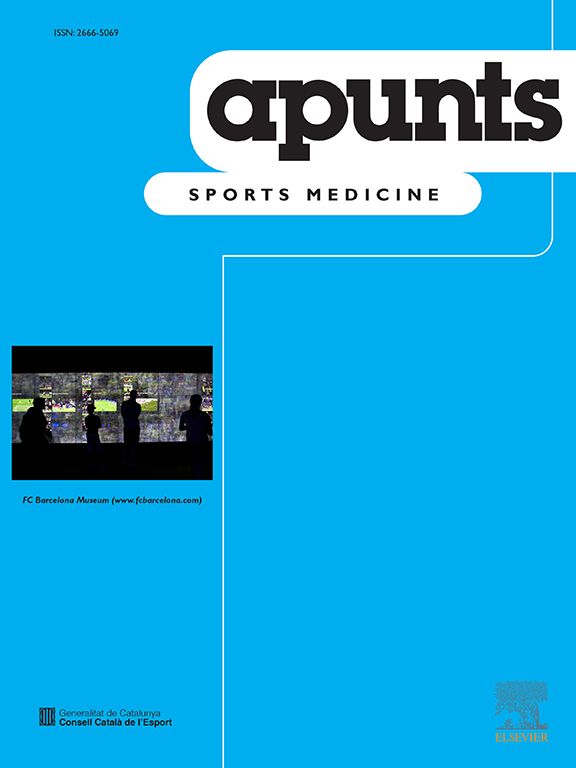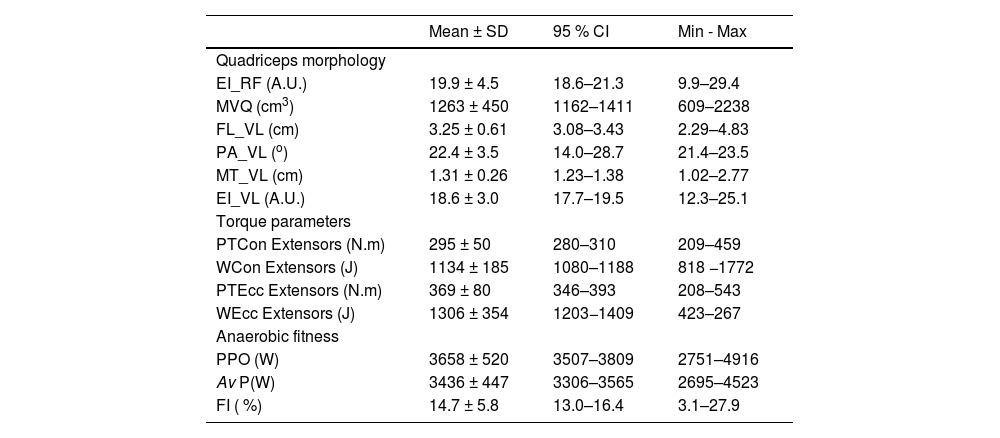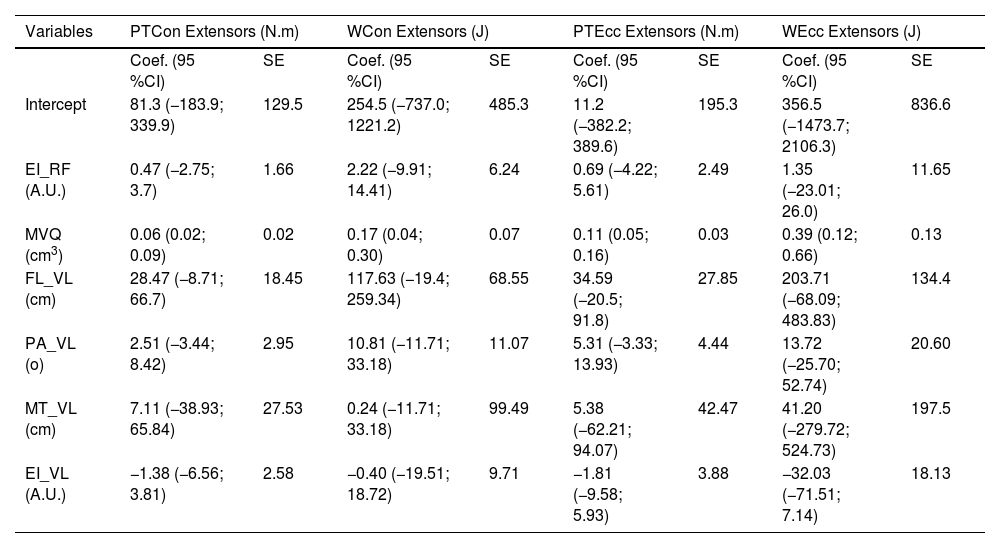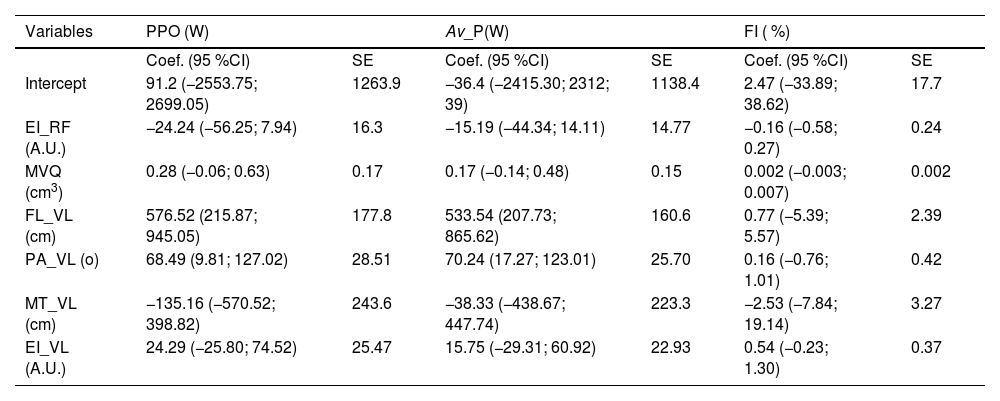The aim of this study was to evaluate the relationship between the morphological characteristics of the quadriceps and torque parameters and anaerobic fitness in soccer players at the beginning of the season.
MethodsForty-eight (26.2 ± 3.6 years, 181±6 cm and 77.3 ± 7.9 kg) male soccer players participated in this study. The following morphological parameters of the quadriceps were evaluated using 2D ultrasound: pennation angle (PA_VL); muscle thickness (MT_VL); fascicle length (FL_VL); Echo-intensity (EI_VL) of Vastus Lateralis; Echo-intensity of Rectus Femoris (EI_RF); and muscular volume of quadriceps (MVQ). The torque parameters were: peak concentric torque (PTCon) and work (WConc) and peak eccentric torque (PTEcc) and work (WExc) of knee extensors. The anaerobic fitness parameters were obtained through a 30-s test of maximum continuous jumps (CJ30s). The following were evaluated: anaerobic power (PPO), anaerobic capacity (Av_P), and fatigue index (FI).
ResultsOnly the MVQ presented a positive and significant relationship with all torque variables (PTConc p = 0.003; WConc p = 0.013; PTEcc p < 0.001; and WEcc p = 0.004). Furthermore, FL_VL and PA_VL were positively and significantly associated with PPO (p = 0.003 and 0.030; respectively) and Av_P (p = 0.002 and 0.011, respectively).
ConclusionIt is concluded that MVQ is positively related to torque and concentric and eccentric work in knee extension. Furthermore, FL_VL and PA_VL showed positive relationships with PPO and Av_P during CJ30s.
In soccer, muscle strength and power constitute fundamental roles that influence player performance and match outcomes.1 Strength is crucial for executing movements such as dribbling, ball control, and powerful shots, enabling players to confront opponents and surmount physical challenges with efficiency.2 On the other hand, power, the capacity to generate strength quickly, is pivotal for sprints, jumps, and changes of direction, confering tactical advantages during the gameplay.3 Consequently, adequate strength and power development not only improves individual athletes’ performance, but also contributes to the collective success of the team, directly impacting results on the field. Recognizing this, a substantial portion of athletes’ physical preparation has been dedicated to refining these physical skills, resulting in changes in muscle morphology, especially in the lower limbs.4
Various methods have been employed to evaluate lower limb strength, one of which entails the utilization of isokinetic dynamometers.5 These devices provide accurate data regarding asymmetries in peak torque between limbs and muscular imbalances between agonists and antagonists, alongside measures of work produced.6 Such findings are instrumental in aiding healthcare professionals (medical team, physiotherapist, physical educator) and sports scientists in both physical preparation and injury prevention for these athletes.
Regarding the morphological aspects related to torque production, studies suggest a correlation between quadriceps muscle strength with morphological parameters, such as muscle volume,7 muscle thickness,8 and pennation angle of muscles like the Vastus Lateralis (VL).9 Furthermore, in soccer, the Countermovement Jump (CMJ) is commonly used to assess lower limb power parameters.10 A review by Ruiz-Cárdenas11 found that only the muscle thickness of the VL correlated with CMJ height (r = 0.28; p = 0.059). The authors concluded that the lower limb muscle architecture has a limited influence on jump performance, likely due to the predominance of neuromuscular components over metabolic aspects in single jumps.12 However, when assessing anaerobic power using the Wingate test,13 it was found that quadriceps muscle thickness, particularly of the Rectus Femoris (RF), is associated with peak and average power. It is noteworthy that anaerobic power assessments involving cycle ergometers may not accurately replicate actions performed during the game in team sports like soccer.
To address this limitation, Dal Pupo14 evaluated the validity and reproducibility of continuous jumps test over 30 s (CJ30s), which consist of maximal continuous vertical jumps performed for 30 s. The authors found that the CJ30s is a suitable method for assessing the anaerobic fitness (peak power, average power, and fatigue index) in athletes, especially those involved in stretch-shortening cycle activities. Nonetheless, to the best of our knowledge, no existing studies have investigated the relationship between quadriceps morphological parameters and anaerobic fitness as assessed by the CJ30s.
Therefore, the present study aimed to investigate the relationship between quadriceps morphological aspects and torque and power parameters assessed by the CJ30s in professional soccer players at the beginning of the season.
Material and methodsParticipantsForty-eight male soccer players (mean age: 26.2 ± 3.6 years; height: 181 ± 6 cm; body mass: 77.3 ± 7.9 kg) participated in the study. The athletes engaged in regular technical, tactical, and physical training and competed at regional and national levels. They reported no injury history within the preceding six months. The evaluation protocol encompassed: a) ultrasonography for quadriceps morphology assessment; b) isokinetic dynamometry for torque parameter evaluation; and c) jumping protocol using a contact mat for anaerobic fitness assessment (Fig. 1). Prior to assessments, an interview was conducted, followed by obtaining informed consent from all participants. This study was approved by local University Ethics Committee and conducted according to the Declaration of Helsinki. Data collection took place between January and February 2024.
Assessment of quadriceps morphologyWe considered quadriceps morphology data and information on muscle architecture, quality, and volume. All assessments involving ultrasonography (US) were performed by a single experienced investigator. To assess muscle architecture, quality, and volume, a B-mode ultrasound system (Mindray, China) was used, with a linear probe, operating at 32 Hz (60 mm, 7.5 MHz, 6.0 cm depth, without a filter). The participant remained in the supine position for 10 min to stabilize body fluids. The architecture of the VL muscle was determined through measurements performed with the subject in the supine position with the dominant knee in full extension. The best fascicle (i.e., the fascicle that could be seen in its entirety from its insertion into the deep aponeurosis to the superficial aponeurosis, or to the end of the field of view of the US probe) in each image was used to analyze fascicle length (FL) and pennation angle (PA). The FL was considered as the length of the fascicular path between the superficial and deep aponeurosis. When the ends of the fascicles were outside the US image, the FL was estimated as recommended in previous studies.15 PA was calculated as the angle between the muscle fascicle and the deep aponeurosis. Muscle thickness (MT) was defined as the distance between the deep and superficial aponeurosis and was calculated as the mean value of five parallel lines drawn at right angles between the superficial and deep aponeurosis along each ultrasound image.16 Muscle quality assessed by echo intensity was determined for the VL and RF muscles. The muscular volume of the quadriceps (MVQ) was estimated from the measurement of muscle thickness between the superficial aponeurosis of the RF and the deep aponeurosis of the Vastus Intermedius (VI). The MVQ was estimated using the equation proposed by Miyatani:17 MVQ = [(MT of quadriceps (RF + VI) * 320.6) + (femur length * 110.9) – 4437.9].
Three images were obtained for each muscle with the subject at rest. The US probe was covered with water-soluble transmission gel and positioned longitudinally to the muscle fibers and perpendicularly to the skin at 50 % (RF, VL) of thigh length.16 The US probe was placed on the skin surface, parallel to the superficial and deep aponeurosis, and aligned with the hyperechoic intramuscular connective tissue of the perimysium. Probe alignment was considered adequate when the superficial and deep aponeurosis were parallel and multiple fascicles could be easily delineated without interruption in the image.18
All US images were analyzed using Image J software (straight line, line color: yellow, version 1.48 v, National Institutes of Health, Bethesda, MA, United States). Echo intensity (EI) was determined according to,19 obtaining the average of the muscles in gray scale. The mean EI was determined using a standard gray scale histogram function and expressed as a value between 0 (black) and 255 (white).
Evaluation of torque parametersPrior to the assessments, participants were positioned on an isokinetic dynamometer (Biodex System 4 Pro; Biodex Medical Systems, Shirley, NY, USA) according to the manufacturers' recommendations for assessing knee extensor and flexor muscles. A familiarization protocol and warm-up were performed (20 submaximal concentric knee extension-flexion repetitions). Although both sides were evaluated (feedback to the team), we only used the torque parameters on the right side. The isokinetic evaluation protocol was adapted from.20 Following the warm-up, participants performed three sets of five concentric knee extension repetitions at 60°/s and a 70° range of motion (30 – 100°, considering 0° = full knee extension). A two-minute interval was given between sets. Subsequently, the same protocol was performed for eccentric knee extensor contractions. The torque signal was sampled at 100 Hz and smoothed using a fifth-order, zero-phase, low-pass Butterworth recursive filter with a cut-off frequency of 10 Hz. For analysis, the best concentric (PTCon) and eccentric (PTEcc) peak torque performed and the largest concentric (Wcon) and eccentric (WEcc) work values were considered.
Anaerobic fitness evaluationPrior to the anaerobic fitness evaluation, participants performed a standard two-minute trampoline warm-up followed by three maximal CMJs. The validated continuous jumping protocol of Dal Pupo 14 was used to assess anaerobic fitness; this protocol consists of maximal continuous vertical jumps per-formed for 30 s. The jump height was measured using a jumping platform (Elite Jump®, São Paulo, Brazil). The mean height of the first four jumps was considered as an indicator of anaerobic power, while the mean height of all jumps was considered as an indicator of anaerobic capacity. The fatigue index was calculated using the following equation: FI = [(mean of four firsts jumps – mean of four last jumps / mean of four firsts jumps)*100]. Peak power was calculated using the equation proposed by Sayers,21 where: Peak Power (W) = [(60.7 × jump height (cm)) + (45.3 × body mass (kg)) – 2055)].
Statistical analysisTo present the results, we used mean, standard deviation, 95 % confidence interval (95 %CI), and minimum and maximum values for descriptive statistics. For inferential statistics, generalized linear models (GLM) were used. Two models were tested: 1) analyses with Gaussian distribution family and “identity” function link; and 2) analyses with Gamma distribution family and “identity” function link. The results are presented as association coefficients, standard error, and 95 % CI. The Akaike Information Criteria (AIC) and Bayesian Information Criteria (BIC) model comparison indicators were applied. Given the range of variables tested, marginal means were presented only for statistically significant relationships. Statistical procedures were performed in R (R Development Core Team, 2022; version 4.3.2 for Windows), and the significance level was set at p < 0.05.
ResultsTable 1 presents the descriptive characteristics of the sample (mean, standard deviation, 95 % confidence interval, and minimum and maximum values) considering values referring to the morphology of the players' quadriceps, assessed by means of ultrasound, torque parameters, assessed by means of isokinetic dynamometry, and anaerobic fitness, assessed by means of the continuous jump test (CJ30s).
Morphological characteristics of the quadriceps, torque parameters, and anaerobic fitness of professional male soccer players (n = 48).
Note: EI_RF (Echo-intensity of Rectus Femoris); MVQ (Muscular Volume of Quadriceps); FL_VL (Fascicle Length of Vastus Lateralis); PA_VL (Pennation Angle of Vastus Lateralis); MT_VL (Muscle Thickness of Vastus Lateralis) and EI_VL (Echo-intensity of Vastus Lateralis). PTCon Extensors (Concentric Peak Torque of Extensors); WCon Extensors (Concentric Work of Extensors); PTEcc. Extensors (Eccentric Peak Torque of Extensors) and WEcc. Extensors (Eccentric Work of Extensors). PPO (Peak Power Output); Av_P (Average Power); and FI (Fatigue Index).
Regarding the results of the general linear model results, we observed that MVQ exhibited a positive and statistically significant relationship with all torque parameters. Specifically, the associations were found withPTCon Extensors (p-value = 0.003), WCon Extensors (p-value = 0.013), PTEcc Extensors (p-value = <0.001), and WEcc Extensors (p-value = 0.004) (Table 2 and.Fig. 2). Notably, no other quadriceps morphology indicators were significantly associated with torque parameters in this sample of professional male soccer players.
Generalized linear models on quadriceps morphology indicators with torque parameters of professional male soccer players (n = 48).
Note: PTCon Extensors (Concentric Peak Torque of Extensors); WCon Extensors (Concentric Work of Extensors); PTEcc Extensors (Eccentric Peak Torque of Extensors); WEcc Extensors (Eccentric Work of Extensors); EI_RF (Echo-intensity of Rectus Femoris); MVQ (Muscular Volume of Quadriceps); FL_VL (Fascicle Length of Vastus Lateralis); PA_VL (Pennation Angle of Vastus Lateralis); MT_VL (Muscle Thickness of Vastus Lateralis); EI_VL (Echo-intensity of Vastus Lateralis); Bold values represent significant associations at p < 0.05.
As shown in.Table 3 and.Fig. 3, FL_VL and PA_VL were both positively and significantly associated with PPO (p-value = 0.003 and 0.030, respectively) and Av_P (p-value = 0.002 and 0.011, respectively). No other quadriceps morphology indicators were associated with anaerobic fitness outcomes in this sample of professional male soccer players.
Generalized linear models on quadriceps morphology indicators with anaerobic fitness of professional male soccer players (n = 48).
Note: PPO (Peak Power Output); Av P (Average Power); FI (Fatigue Index); EI_RF (Echo-intensity of Rectus Femoris); MVQ (Muscular Volume of Quadriceps); FL_VL (Fascicle Length of Vastus Lateralis); PA_VL (Pennation Angle of Vastus Lateralis); MT_VL (Muscle Thickness of Vastus Lateralis); EI_VL (Echo-intensity of Vastus Lateralis); Bold values represent significant associations at p < 0.05..
The aim of the current study was to evaluate the relationship between quadriceps morphological aspects in torque and anaerobic fitness parameters in soccer players at the beginning of the season. Our results indicated that MVQ was positively related with all torque parameters. In addition, both FL and PA of VL showed positive associations with peak power output and mean power obtained during the CJ30s.
Our findings showed a significant relationship between MVQ with torque and work (concentric and eccentric) of knee extensors, this result is similar to previous studies. Lanferdini,7 in cyclists, observed that the muscular volume of the right (r = 0.56) and left (r = 0.59) quadriceps presented positive and very strong correlations with the right and left maximal voluntary isometric contraction (MVIC), respectively. Hori22 also found a significant relation (r = 0.78) between MVQ and knee extensor isometric torque. This relationship can be expected, because the muscle size (i.e., muscular volume and/or cross-sectional area) is a primary determinant of maximal strength for different muscles.23 These results reinforce the clinical relevance of the importance of using different training strategies that promote increased quadriceps muscle volume to produce torque, neuromuscular work and consequent increase in performance.
A recent study (Lanferdini et al., 2025) 24 with athletes from various sports, such as soccer, futsal, American football, and basketball, showed a PA_VL like that observed in our study (20.69 ± 2.95 vs. 22.4 ± 3.5, respectively). Studies have shown a certain inconsistency in the relationship between the PA_VL and peak torque, with some studies finding a weak relationship,7,24 and other studies observing no relationship.25 Previous studies found no relationship between RF muscle fascicle length and isokinetic concentric peak torque,26 just as no relationship was observed between FL_VL and peak torque.27
However, Raj28 observed a relationship between FL_VL and vertical jump height, and Kumagai29 found a significant and negative correlation between 100-m sprint time and VL fascicle length. The FL can influence muscle contraction speeds, but not necessarily muscle strength, because if all sarcomeres shorten simultaneously, the cumulative shortening distance, and thus velocity, will be greater.30 These results are clinically relevant, since the inclusion of eccentric overloads in the knee extensors, as has already been observed for the hamstrings,31 could provide increases in fascicle length by adding sarcomeres in series, improving performance in activities involving power, such as jumping.
In the present study, the other morphological parameters of the quadriceps (echo-intensity, pennation angle, and muscle thickness) were not related to peak torque and work, although some studies have observed a positive relationship between quadriceps echo-intensity and MVIC,32 and rectus femoris pennation angle and muscle thickness are associated with peak torque in different isokinetic velocities,33 however, the samples tested in these studies were physically active men. Therefore, the characteristics of the sample and the training status may influence the results. In this sense, the athletes tested in the present study were in pre-season, and therefore the adaptations related to muscular strength may still be being developed, without significant morphological changes.
The peak power output and average power variables obtained in the 30CJ showed a significant relationship with FL and PA of VL. Some studies have found similar results, such as significant associations between the FL of VL34 and PA of VL35 with power obtained in the Wingate anaerobic test. Kordi36 found a high relationship between PA of the VL and peak power (r = 0.81) in a maximum sprint test on a cycle ergometer. According to the authors, this could be expected, since the PA is known to be related to muscle size indices, suggesting that a high PA is advantageous for neuromuscular power. This could explain the relationship observed in the present study in a test also using continuous vertical jumps, because power production is one of the main determining factors of performance.37 Furthermore, with a greater PA, force and, consequently, power, can be increased, as there is an increase in the number of sarcomeres in parallel that contract simultaneously to exert force.38
Activities that involve movements at high velocities can benefit from longer FL (i.e., a high number of sarcomeres in series) as this is associated with a high maximum contraction speed of the muscle fiber.38 This can be confirmed in the study by Methenitis39 in which performance in vertical jump tests (countermovement jump and squat jump) was positively related to the FL of the VL. The present study corroborates these findings because the peak anaerobic power was determined with the values of the first four vertical jumps.
Finally, some limitations can be highlighted in this study. First, only one speed (60°/s) was used to evaluate isokinetic torque. It is recommended that other speeds be tested, since variables such as FL may present a better correlation with torque. Second, the athletes tested were at the beginning of the competitive season, so these analyses could be performed during the season or at the end, which may provide important results related to muscular adaptation in the quadriceps muscles and the relationship with physical performance. Also, no data were obtained on the athletes' training routines, which could interfere with the results of the results. Finally, we did not use limb dominance, but rather the right limb, to evaluate the US parameters. However, our study has strengths, as we evaluated 48 soccer players who compete at regional and national levels. Furthermore, we used standardized measures in the evaluations, as well as other measures that are little explored in this population, such as muscle morphology and anaerobic fitness using continuous vertical jumps.
ConclusionFrom our findings it can be concluded that the muscular volume of the quadriceps is related to peak torque and concentric and eccentric work of the knee extensor muscles. Furthermore, the fascicle length and pennation angle of the vastus lateralis showed significant correlations with peak power output and average power during the CJ30s, representing anaerobic power and capacity, respectively.
None.














